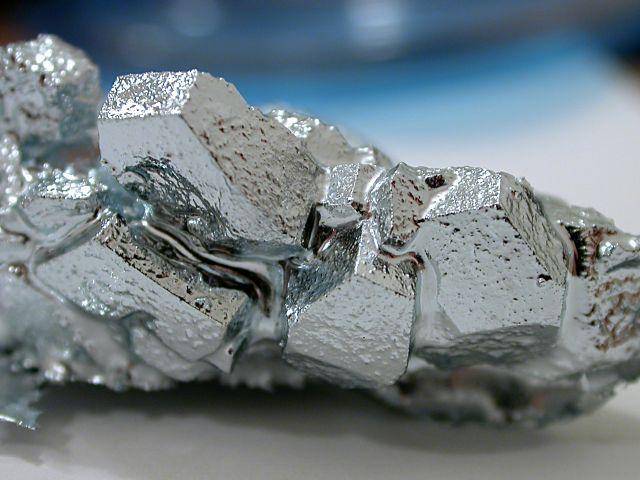Source of the photo
http://gensonscience.wikispaces.com/Gallium
Author of the description
Gruiz Katalin

Atomic number
| 31
| Atomic mass
| 69.72 g.mol -1
| Electronegativity
| 1,8
| Density
| 5.1 g.cm-3 at 20°C
| Melting point
| 29.8 °C
| Boiling point
| 2204 °C
| Vanderwaals radius
| 0.161 nm
| Ionic radius
| 0.083 nm (+3)
| Isotopes
| 6
| Electronic shell
| [ Ar ] 3d10 4s24p1
| Energy of first ionisation
| 578.6 kJ.mol -1
| Energy of second ionisation
| 1978.8 kJ.mol -1
| Energy of third ionisation
| 2389 kJ.mol -1
| Energy of fourth ionisation
| 2962.3 kJ.mol -1
| Standard potential
| - 0.52 V
|
|
|
Solid gallium is a blue-gray metal with orthorhombic crystalline structure; very pure gallium has a stunning silvery color. Gallium is solid at normal room temperatures, but as well as mercury, cesium, and rubidium it becomes liquid when heated slightly. Solid gallium is soft enough to be cut with a knife. It is stable in air and water; but it reacts with and dissolves in acids and alkalis.
Applications
Liquid gallium wets porcelain and glass surfaces; it forms a bright, highly reflective surface when coated on glass. It can be used to create brilliant mirrors. Gallium easily alloys with most metals, so it is used to form low-melting alloys. The plutonium pits of nuclear weapons employ an alloy with gallium to stabilize the allotropes of plutonium.
Analog integrated circuits are the most common application for gallium, with optoelectronic devices (mostly laser diodes and light-emitting diodes) as the second largest end use. Gallium has semiconductor properties, especially as gallium arsendite (GaAs). This can convert electricity to light and is used in light emitting diodes (LEDs) for electronic display and watches.
Gallium is used in some high temperature thermometers.
|
